The new regulation prescribed to amend the official letter according to the patter created by Prince Devawongse Varoprakar, but the division of labour mainly based upon civil service in Ministry of Interior. I had read up on the act, “Feudal Characteristics of Civil Servants” and found that the administrative division in the Ministry of Interior was divided into 3 major departments, namely the Central Department of Interior, the Permanent Secretary served as the head of the Department of Interior (Northern divsion). Department of Provincial Administration was directed by Phraya Maha Ammat and Phraya Cha Saenyobordi led the Department of Defence. Originally there were only the Central Department of Interior and Defence, Department of Provincial Administration was set up later.
In my point of view, Department of Interior and Department of Defence had been established in the reign of King Borom Rachathirat III, son of King Trailokanat and Chetthathirat who served as Trailokanat’s regent in the north, reside in Phitsanulok. Thailand had got 2 kings for 3 years between 1488 and 1491. Another government house was built in Phitsanulok. After the reign of Borom Rachathirat, Somdej Phra Chetthathirat occupied the throne in the name of Borommaracha II and resided in Ayutthaya. The officials from Phitsanulok came to work with officers in Ayutthaya since then. The duty of Department of Provincial Administration was only mentioned that it involved with cannons, perhaps artillery personnel in the Royal Army, but civil servants in Northern Division and the Department of Provincial Administration worked together with the Central Department since Rattanakosin or Ayutthaya period. Therefore, no one knew what their previous duties had been.
I would like to remain the names of each department. Thus, the names of department were the same with different duties. Department of Central Interior was responsible for everything, led by the Permanent Secretary. Accountant General was the head of financial officers, the status equalled to Vice Permanent Secretary. Northern Division of Department of Interior had been in charge of suppression and foreign affairs. Later, foreign affairs were transferred to the Permanent Secretary and the Northern Division served as government attorney. Department of Provincial Administration had overseen local government. These were called, the department of Central, Northern, and Provincial Administration like before. Ministry of Interior divided into 3 departments like that throughout my term as the Minister of Interior.
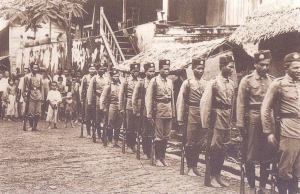
Police training in the reign of King Rama. Police training in European pattern had begun during the reign of King Rama V by hiring an English man, Samuel to work as the commander, with title of Luang Ratyathiban Bancha
There were also other two departments which named “Local Police” directed by “Luang Suthep” and “Metropolitan Police” administered by “Luang Phitsanuthep”. From the past, there had no hint about their duties but the two directors were civil servants and received military pension as officials in Ministry of Interior. Police was defined as inspector. The names of Permanent Secretary of both departments were rhymed, Khun Petch Intra, Khun Maha Vichai, Khun Phitsanusean, and Khun Pansatarn. In the literature that Phai Kaew served as “Khun Pansatarn” could simply said that he was the Permanent Secretary (Deputy) of the Department of Metropolitan Police. His responsibility was to control and patrol checkpoints in Kanchanaburi. It could be assumed that both departments previously served as immigration officers at the border before transferred this duty to Mon, and set up the “Department of Attamat”. Thus, the scope of the two police departments was lessened to oversee servants, under Ministry of Interior. I had discussed about the former duty of these departments because there were two new departments setting up when I served as the minister, total of 4 departments that I would tell the causes of their establishment later.
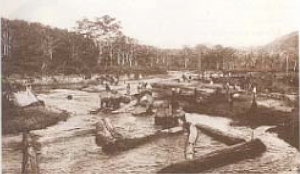
Isasiatic Company provided the forestry show by elephants at Tumbon Pamu, Phrae province during the inspection trip of Prince Bhanubandhu Vongsevoradej
In provinces, apart from the Department of Attamat, there were no officers coped with thieves and crime. After the implementation of Provincial Administration, the king took the form of “Yong Dams”, which controls and uses guns like a soldier. It was suitable for a large area, since it hadn’t required a lot of people. There was no Thai name for Yong Dams so I used the name of local police due to their identical duties. After that, I decided to set up the Department of Metropolitan Police as the Department of Detectives (C.I.D) but the mission failed due to the lack of specialists. Marshal-Admiral Paribatra Sukhumbandhu, Prince of Nakhon Sawan, served as the Minister of Interior and set it up on behalf of “Central Department of Police”.
Royal Forest Department was another new department. The reason for establishing the Royal Forest Department had been the result of the large amount of teak forests in Myanmar and Thailand. When England acquired the districts of Mon from Burma The British set up a sawmill in Mawlamyung (Mawlamyine), cutting teak trees in the Salween River basin in Mon region and sawing it into square and plank to sell abroad as a product. Teak forests in Thailand were also abundant, but in Payap province, down to Tak, Kamphaeng Phet and Uthai Thani, traditionally, the people cut down teak in these 3 cities to sell in Bangkok. But there were usually small trees that often used as a base for tying rafts to people in the river, the so called “raft pillar”. After making a trade agreement with a foreign country, sawmills were built in Bangkok meant to sell Thai teak in abroad. Therefore, the production of teak products in Thailand had begun to export to foreign countries since the reign of King Rama IV. Teak forestry had been developed more and more in both Thailand and Mon.
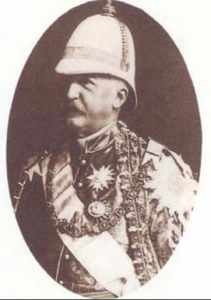
Mr. Roland Yagmin, former Belgian Minister of Interior served as a civil servant in Thailand as general consultant in the reign of King Rama V during the year 1892-1899, was given the title of “Phraya Aphai Raja” was one of those who had greatly benefited Thailand in the era of change at that time.
In the reign of King Rama V, the foresters in Mon region wanted to cut teak into Chiang Mai via the Salawin River. Therefore, they came across to talk with the Burmese merchants who placed themselves under the King of Chiang Mai, requesting permission to cut teak by paying the “the fee of stump” of every teak to be cut down. At that time, the King of Chiang Mai still had the absolute power in a country like the Kingdom. For the sake of the benefits of the forest, those Burmese people had been allowed to forest in many places along the Salawin River, with the belief that he could command as he had previously commanded the Burmese who lived in Chiang Mai. But the foresters had to borrow money to run business only focused at making profit. Some of them refused to follow the regulations from the king of Chiang Mai. As a consequence, the king of Chiang Mai disallowed to cut tree, etc. Those Burmese took advice from the new lawyers in Burma to complain at the British Consul in Bangkok. The consul supported them by asking Chiang Mai to pay compensation for them.
Initially, there were few of lawsuits. Chao Phraya Rattanathibet (Phum) when still was Phraya Thep Arjuna worked as the governor of Chiang Mai solved the case but Chiang Mai city still allowed the forest. The cases about the forest then increased more and kind of political issue since the consul involved. With support of the consul, those Burmese foresters felt more confident to do so. Thailand and British government had to make an agreement to have International Court and their officials in Chiang Mai. As for the establishment of teak forest in Thailand, during Rama V period, many Western companies had come to sell teak wood in many department stores. The companies went up to ask for forestry in Payap province, to saw and sell teak in Bangkok and it always was the argument between the consul and the government. The king consulted with Chao Phraya Apairaja (Roland Yagmins), saw that if the Royal Forest Department was established in Thailand for forest control in accordance with the British government arranged in Burma. So, for the first step, we had to borrow experts from the British government in Burma to become a Thai trainer who would continue to be a forest worker. Because when the Royal Forest Department had already established, foresters could contact the Royal Forest Department just like British process in Myanmar. There was no need to rely on consulates. Significantly, this would separate the forest out of the city affairs and preserve teak forest in Thailand. Once the Royal Forest Department was completely established, the nuisance was eliminated sine in the past foreigners who wanted to file a complaint or to request anything from the Thai government had to ask to consulate. Consul then made a request letter to the Ministry of Foreign Affairs to consider which ministry was related to the request. Then, the letter was sent to that ministry. After that ministry replied to the Ministry of Foreign Affairs, the Ministry of Foreign Affairs was finally able to response to consul. This obviously took so many days to complete.
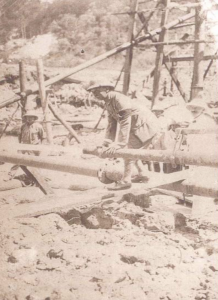
Prince Damrong Rajanubhab inspected the mining at Nong Pet, Nakhon Si Thammarat Province
When the Royal Forest Department had already started, if those foresters were foreigners, they had to submit the request via the consulate. If there were Thai people, they had to proceed with the Royal Forest Department. Shortly afterwards, foreigners stopped making a request via the consul and applied directly to the Royal Forest Department. The consul had no authority to take part since foresters claimed that it was unrelated to politics. They preferred to do the most convenient way to their business. The two royal intentions had been fulfilled, having forest preservation and maximising the national interest, so the Royal Forest Department has existed since then.
Department of Mine had been administered by “Krom Rajlohakij Poompitthaya”, shortly, “Krom Rae”. This department was under the Ministry of Agriculture. The reason to set up the Department of mine was that, an Italian foreigner named Suchatee received a gold mining card concession in Bang Taphan. That foreigner went to find a business partner by saying that there was a plenty of high quality- gold in Thailand. The news spread widely. Foreigners were waking up to ask for a concession to make a gold pond in other places in Thailand. At that time, there were no laws and specialists to work as officers in mining. Thus, the foreign specialist who specialised in mineral processing was employed as an instructor. Department of Mine was established in the Ministry of Agriculture in 1880, but the officers of Department of Mine didn’t know the provincial customs, so they often argued with the governor. Until when I was the Chancellor of the Ministry of Interior Therefore, please transfer the Department of Minerals from the Minister of Interior. I transferred the Department of Mine to be under the Ministry of Interior to adjust the provincial affairs. The Department of Mine then returned to be under the Ministry of Agriculture in the late reign of King Rama V, during the term of Chao Phraya Wongsanuprapat as the minister. It could be said that the Department of Mine had been under the Ministry of Interior only for a temporary period of time.
The left side of Luk Kun hall was the office of Ministry of Interior had greatly changed. There was insufficient area for use. I agreed with the Minister of Defence to talk to the Ministry of Royal Household that the Ministry of Defence gave the middle room to the Ministry of Interior. The warehouse needed to be moved to somewhere else. That middle room was used as meeting room and ceremony. Sometimes, it was a living room for guests. A year later, the Ministry of Defence only looked after military and moved out. The right side of the hall then belonged to the Ministry of Interior. However, there wasn’t enough. The Department of Local Police and Royal Forest had to find other locations to set up their offices while the Department of Mine was at the Ministry of Agriculture.
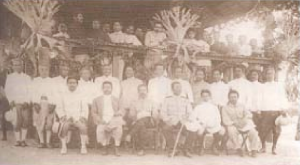
Somdej Krom Phraya Damrong Rajanupab inspects Udon Thani province in 1906.
His Majesty decided to centralise all the provincial administration to be under the Ministry of Interior and gathered provinces as Monthon (Circle) also under the Ministry of Interior. The governor of Monthon was under the Ministry of Interior so that the administration would be managed more easily but still couldn’t have the Minister of Interior. Even so, provinces had been started to integrate into Monthon with a high commissioner in the province. When I was appointed me as the Minister of Interior, these were the provinces that were under the Ministry of Interior; “Monthon Lao Chiang” which later changed its name to “Payap Province” governed by Phraya Rattanathibet (Chao Phraya Pollathep at that time) resided in Chiang Mai, “Monthon Lao Puan”, later changed to “Udon Province” governed by Krom Luang Prajak Sillapakom, at the time he was the Minister of Royal Household, served as a high commissioner at Nong Khai, “Monthon Lao Kao” later changed to “Monthon E-San” had Krom Luang Pichit Preechakorn as a high commissioner at Champasak province, “Monthon Lao Klang” was Laos, the province among Nakhon Ratchsima, Monthon Lao Puan and Lao Kao ruled by Krom Luang Sappasittiprasong, a high commissioner at Nakhon Ratchsima. These five Monthon were in charge of Ministry of Interior. Provinces in the western coast were gathered as Monthon to be under the Ministry of Defence with a purpose of maximising national interest.
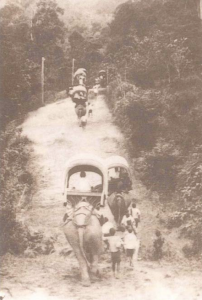
The journey of Krom Phraya Damrong Rajanupab inspected Udon Thani province in 1906, which had elephants, wagons and oxen as important vehicles.
When I was the Minister of Interior, Phraya Thipkosa was the high commissioner at Phuket and directed to the Ministry of Defence. Actually, the High Commissioner of Monthon was responsible for preserving the royal territory of the Kingdom, not to arrange the administration. The royal intention was to start organising the inner provinces first and then expanded the identical pattern throughout the royal territory. Even after I had been appointed as the Minister of Interior, His Majesty still not allowed transferring the provinces from the Ministry of Defence and Krom Tha to the Ministry of Interior. Probably, His Majesty would like to see my performance first before authorising me to oversee the country as a whole.
I had noticed many obstacles in each province during my inspection trip such as the transportation. It had taken more than 10 days from Bangkok to Phitsanulok. To visiting and administrating the provinces by ministers ‘selves was out of our ability. Ministers couldn’t follow up accurately how the governor in each province interpreted and implemented their order. Monthon was a great mean to solve this problem. Putting 5 or 6 provinces in one Monthon, calculated the appropriate size that the governor could manage by himself together with the ministers (senabodi). To be simply, the governor was the leader and the ministers were assistants.
Furthermore, budget was another problem. Everyone agreed to give up “Kin Mueng” since such system allowed the officers to take personal benefits. Also, only qualified people had been appointed to work. Then, those qualified people were from Bangkok. The government demanded that the salaries of civil servants be enough to make a living.
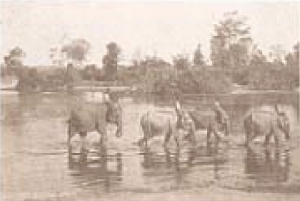
Once I returned Bangkok, I informed the king as expressed earlier. His Majesty agreed to centralise the provinces into Monthon and asked me to list the governor for each Monthon. Regarding the budget, Prince Narathip Praphanphong as a Deputy of Ministry of Finance discussed with me to figure out the solution. The river should be used as the borderline of Monthon. Southern provinces were Ayutthaya, Lopburi, Saraburi, Ang-Thong, Singburi, Inburi, put together as one Monthon, called “Monthon Krung Kao” (old capital) since the centre was at Ayutthaya.
Provinces along Bang Pakong River were Prajinburi, Nakhon Nayok, Panomsarakam, Chacheongsao put together as “Monthon Prajin” (Later relocated to Chacheongsao because the Monthon was extended to the coast. Panat Nikom, Chonburi, and Bang Lamoong were included.)
Provinces along Nan and Yom River were Pichit, Phitsanulok, Pichai, Sawankalok, Sukothai, put together as “Monthon Phitsanulok”.
In practice, only two Monthon were set due to the lack of eligible governers. Chao Phraya Surasiwisitsak (Chaya Kalyanamittra) at that time was also Phraya Sri Suriyarajwaranuwat Governor of Phichai Province, when I went up to inspect the northern provinces, I saw that he was a wise person. Another one was Major General Phraya Ritthirong Ronachat (Suk Chuto), whom I thought he was qualified, but he was a military officer. Therefore, Phraya Sri Suriyarat Ratchanuwat was appointed to serve as the governor of Monthon Phitsanulok while Phraya Ritthirong Ronachat served as the governor of Monthon Prajin. The title of Monthon governor was “Thesapibal Commissioner” to differentiate it from “commissioner” before changed to “Samuha Thesapibal” in the reign of King Rama VI. Suddenly in 1893, there was a dispute between Thailand and France. Monthon Prajin had sent forces and weapons to stand by at the Monthon in the east coast faster than anyone expected. This was the first time to see the advantage of having Monthon. In the late 1893, Krom Khun Marupongpipat was designated to work as Thesapibal Commissioner of Monthon Krung Kao. Phraya Dussakorn Palat (Yoo) who had been Thesapibal Commissioner of Luang Prabang before served as Thesapibal Commissioner Nakhonsawan. A while after he took the position, he felt that he couldn’t do civil service as good as he did to military affairs so he asked His Majesty honestly. His Majesty then appointed him to be royal guard. Phraya Kraipet Rattanasongkram (Chae Bunnag) who was the provincial governor of Samut Songkram had to serve as Thesapibal Commissioner Nakhonsawan. Later in 1893, Krom Luang Sappasitprasong was promoted to high commissioner of Monton E-San, Nakhon Ratchasima, Buriram, Nang Rong, Chaiyapum were put together as “Monton Nakhon Ratchasima”. Chaopraya Bodindecha (Sing Singhaseni) served as the Thesapibal Commissioner of Monthon .Nakhon Ratchasima
Regarding to finance, I said clearly that to arranging the provinces needed to pay a lot of money. If the Ministry of Finance provided insufficiently, the project would be failed. Therefore, when I took an inspection trip to provinces, I was told to collect tribute. I was so reluctant because I only planned to gain knowledge to extend my vision, not for other business. Importantly, it was the first time people see me. They would wait to see how I was. If I forced for money everywhere I visited, they would understand that I was fierce, no mercy. But, also, I couldn’t deny the Finance minister. I expressed my concern to him. I tried to find solutions, consulted with Phra Worawut Phochai, the tribute director, who was promoted to Phraya when I was in the Ministry of Interior. He knew well how to deal. Thus, I got the idea of discount. I asked Krom Nara, how much the discount could be. Finally, I got a deal of 50% discount if they paid with me during my trip.
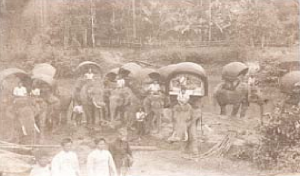
The procession of a government inspection while crossing the Pattani River.
Those who wanted to release had to pay me by cash. This method was very successful. There was no use of note at that time. I had to find another boat to load money. His Highness also asked me to econimise such as to set a low rate of salary. I predicted that we didn’t have to spend too much since there were only 4 Monthon. In the first phase, only the Thesapibal Commissioners got salaries. More budgets would be needed gradually after we recruited and hired more officials. This harmonised with the ability of the Ministry of Finance. After consulting and understanding with the Ministry of Finance, I relieved and continued focusing at the provincial administration.
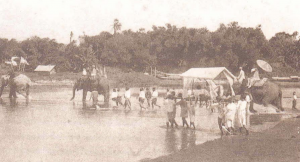
Somdej Krom Phraya Damrong Rajanupab took this photo at the first meeting of the Ministry of Interior in 1895
From left-right
Sitting Row
- Phraya Cha Saenyobodi (Thai)
- Chao Phraya Surasi Wisisak (Chay Kalyanamittra)
Standing Row
- Chao Phraya Suraphan Phisut (Thet Bunnag)
- Phraya Ritthirong Ronachat (Suk Chuto)
- Phraya Prasit Sulakarn (Sa-ard Singhaseni)
- Phraya Aphai Ronarit (But Boonyaratphan)
Standing Row 2
- Phraya Ratchawaranukun (Uam)
- Krom Mueng Damrong Rajanupab (Somdej Krom Phraya Damrong Rajanupub)
- Krom Muen Maruphong Siriphat (Prince Watthananuwong Krom Khun Maruphong Siriphat)
Standing row 3
- Phraya Dassakonpalas (Yoo)
- Phraya Tipkosa (To Chotiksatian)
- Phraya Maha Ammat (Seng Viriyasiri)
